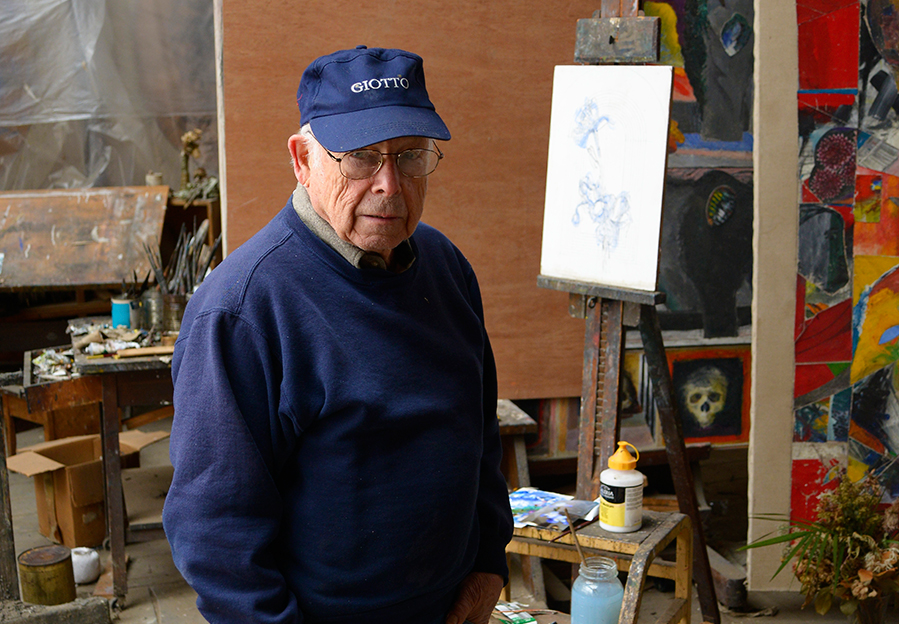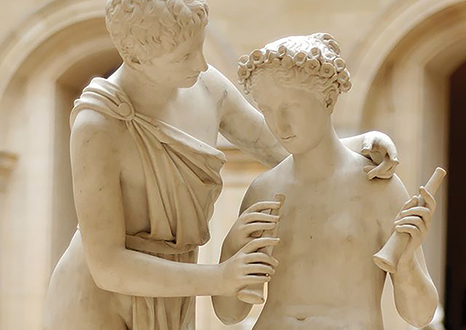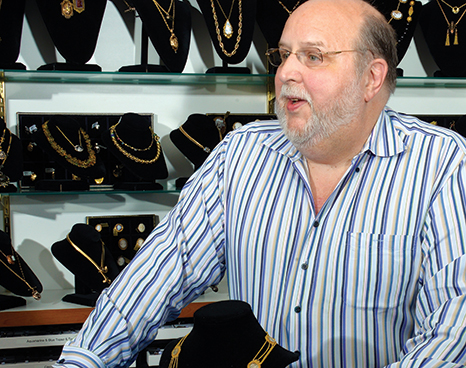For Edward Giobbi, the passion for painting and for preparing prosciutto is all of a piece.
“It’s all part of me – gardening, cooking, painting, writing,” he says. And no one part is superior to the other.
“A stonemason who knows how to build a wall is just as creative as a painter. The word ‘artist’ is among the most overused in the English language. Everyone today is an artist. They didn’t call themselves artists in the Renaissance. They were craftsmen.”
As Giobbi talks before a crackling fire in the airy addition of his Katonah home, many of the arts – Should we call them crafts? – are in play. Sounds of Mozart, Ravel and Rimsky-Korsakov fill the air. Books line a corner case, including the four cookbooks Giobbi has written. Paintings, both abstract and figural, hang or lean everywhere. Among them is a large round work – reminiscent at once of a shimmering mandala and a vinyl record – that’s all about vanishing perspective and the interplay between two- and three-dimensionality. Stories spin about Giobbi’s equally accomplished friends – the chef Jacques Pepin, whose quote adorns the back flap of Giobbi’s “Pleasures of the Good Earth”; the late Southern historian-novelist Shelby Foote, first introduced to most of America in Ken Burns’ landmark “Civil War” series.
“Shelby Foote gave me a chapter of one of his books,” Giobbi recalls. “He wrote everything in longhand. It looks like medieval script. Not a mistake on the page. …He knew history, he knew the battles so well. He would read everything he could get his hands on. He had it all in his head. Then he would write it.”
In his artisanal way of thinking, Giobbi might call Foote a scribe. “The scribes were very important, very well-read,” Giobbi says. “They kept culture alive.”
But then, so does a nourishing minestrone, like the Genoan-style one he makes with vegetables from his garden and serves room-temperature in the summer, adding pesto at the last minute. (Long before there was seasonal cooking or a farm-to-table movement, there was Giobbi.) Or the antipasto featuring hard pears and cauliflower dipped in batter that he prepared at Christmastime. These are the recipes, the memories, of a child born in Waterbury, Conn., to Italian immigrants, who spent time on his grandfather’s farm in Centobuchi on the Adriatic coast, who still goes to Italy twice a year with wife, Elinor – she of the Southern charm and lilt and fine bone structure – who ventures down to Arthur Avenue in the Bronx every Friday not just for the authentic Italian foodstuffs but for the conversations and perhaps a recipe or two from the old-timers.
“Italian-American food is a corruption,” he says. “It’s not like real Italian food.”
It’s on Arthur Avenue that Giobbi gets the hams to make his prosciutto. These are not the puny 9-pounders but 45- to 50-pound hams that come from huge pigs raised in upstate New York. The art of making prosciutto, which Giobbi learned from his grandfather, is not for the faint or impatient of heart, as you must start in December or January and then wait at least nine months – a year being preferable.
Curing the ham involves removing the pelvic bone and foot fragments from where they join the thighbone, to prevent bacteria, and rubbing them well with kosher/coarse salt and black pepper. You cut off the skin from the inner thigh. (Salt and save it for soup.) Ditto any loose meat and fat. (Save this for making sausage.)
After shaping the ham, you massage it to get any blood out, then give it a generous salt-and-pepper rubdown. Place the ham, skin-side down, on a salted, noncorrodible tray in a cool, dry place (30 to 40 degrees) where air circulates. Sprinkle the ham with salt as it is absorbed, taking care to salt the exposed knobs. (The French, Giobbi writes, use cognac on the femur knob; Italians in certain regions use grappa.) After a week, you put three sticks under the ham to keep out moisture. Three weeks later, you hang it in a cool, well-ventilated space for 10 days.
Next you rub salt on the skin side and place the ham skin-down on the tray, adding a 30- to 50-pound weight atop the ham to squeeze out the remaining moisture. Leave it that way for another 10 days, removing the weight every two days to give the ham another salt rub if it becomes too moist. After this period, you wrap the ham in a cheesecloth, tying it securely to keep bugs out, and hang it in a well-ventilated place.
Now your part is done. You must await the robust delights of your prosciutto through spring, summer and fall. When it’s ready, cut an inch of skin, fat and outer dried flesh from one side and save it for soups and stews. Slice the meat paper-thin and serve it as a first course. Keep it in a cool place, but not necessarily a refrigerator.
You’ll find this and 339 other recipes in “Pleasure of the Good Earth,” which Giobbi himself illustrated. It features a foreword by Alice Waters, a leader in the organic, locally sourced movement, and fulsome praise from the late food writer Craig Claiborne, who called Giobbi “one of the finest and most enthusiastic of cooks and gardeners.”
Writes Jacques Pepin: “…he understands the product first, and his close communion with the earth and nature is reflected in the quality and integrity of his recipes.”
Indeed, Giobbi is so well-associated with food that you forget he has a day job. Winter mornings, he’ll put a pot of soup on and sketch in the house, taking about a 45-minute lunch break to relax with some TV, which puts him to sleep for about 15 minutes. Then he’ll head to the barn, which is his studio, to work in various media – oils, watercolors, tempera, sculpture. In the summer, he’ll be in the garden early in the morning and in the evening, painting in-between. It’s all about catching the light, working with the seasons, on canvas and on the table.
Part of Giobbi’s studio – which has fabulous northern exposures for painting – was destroyed during Hurricane Irene in August 2011. The handsome addition contains parts of works – a whole year’s worth were lost – that have been refashioned into colorful collages. The series is called “Up Yours, Irene.”
Despite the title, Giobbi is philosophical – stoical even – about nature. Still, he is single-minded in pursuit of his craft – which is really the art of living.
“Anything for the good of the art,” he says. “If it doesn’t fit, I throw it out.”





